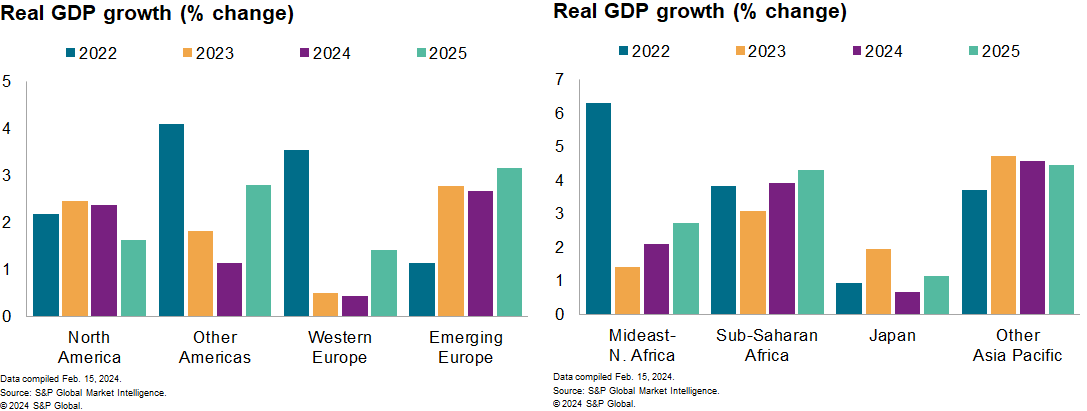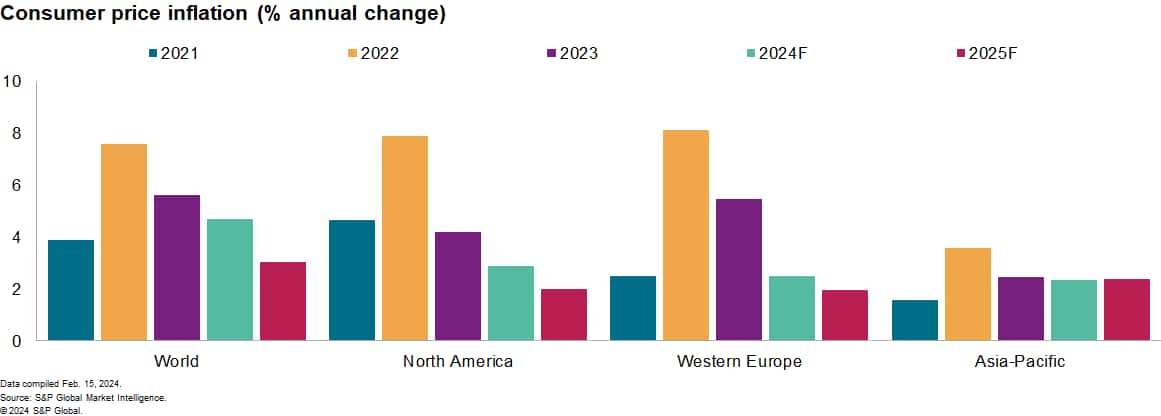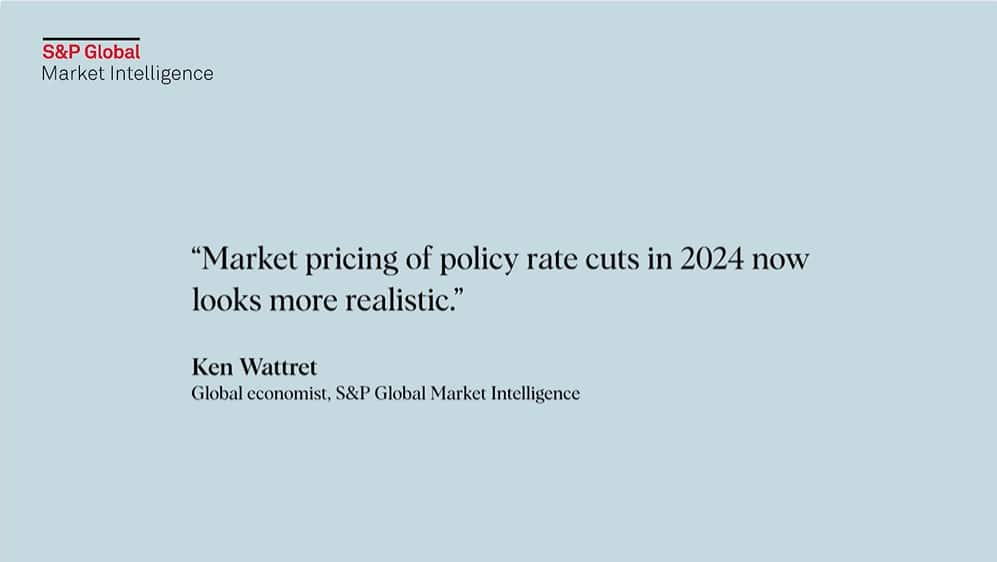S&P Global Offerings
Featured Topics
Featured Products
Events
S&P Global Offerings
Featured Topics
Featured Products
Events
S&P Global Offerings
Featured Topics
Featured Products
Events
S&P Global Offerings
Featured Topics
Featured Products
Events
Corporations
Financial Institutions
Banking & Capital Markets
Economy & Finance
Energy Transition & Sustainability
Technology & Innovation
Podcasts & Newsletters
Corporations
Financial Institutions
Banking & Capital Markets
Economy & Finance
Energy Transition & Sustainability
Technology & Innovation
Podcasts & Newsletters
BLOG — Feb 16, 2024

By Ken Wattret
Learn more about our economic data and forecasts
Our annual global real GDP forecast for 2024 has been revised up from 2.3% to 2.5%. This primarily reflects a significant upward revision to our US forecast, related to unexpectedly strong growth in the final quarter of 2023. Some of that strength is also expected to persist in early 2024. The 2024 growth forecasts for Canada, the eurozone, the UK and Russia have also been revised higher in February's update, although to a lesser extent. Western Europe's growth underperformance is likely to persist in the near term. Our global growth forecast remains somewhat higher than market consensus expectations, supported by positive signals in our Purchasing Managers' Index (PMI™) data.

Global PMI data continues to point to a gradual improvement in economic conditions. The JPMorgan Global Composite PMI output index compiled by S&P Global improved for the third month in a row in January, reaching its highest level for seven months. Forward-looking aspects of the survey were also indicative of further improvements ahead, with new orders and future output expectations rising to their highest levels since mid-2023. Improving confidence in demand prospects was also reflected in a pick-up in employment. Looser financial conditions are helping to stimulate activity in services. While manufacturing conditions remain relatively challenging, in the eurozone particularly, progress in reducing inventories is providing some support.
Core inflation rates have continued to fall but the outlook is more uncertain owing to shipping disruptions. While headline global consumer price (CPI) inflation edged up in December 2023, according to our estimates, the core rate declined for the ninth straight month. Global core goods CPI inflation dropped to just 1.3% in December 2023, according to our estimates, 7 percentage points below the early 2022 peak. PMI data has started to show some effects from disruptions to shipping routes, including a lengthening of suppliers' delivery times in January for the first time in a year. Still, manufacturing price indices remained relatively stable, and the Material Price Index (MPI) compiled by Market Intelligence saw a sharp fall in mid-February, with weakness broad-based. Consistent with various related indicators and rules of thumb, the inflationary effects of the shipping disruptions do not appear to be large enough to materially alter the outlook. We will continue to monitor the upside risks. Global CPI inflation for services remains relatively sticky, edging down to 4.6% in December 2023, and we continue to expect a gradual moderation.

Financial market expectations of policy rate cuts in 2024 now look more realistic. At the peak in December 2023, cumulative rate cuts of over 160 basis points by the US Federal Reserve and European Central Bank were priced into futures markets for 2024. Those expectations have been pared back to around 90 and 110 basis points of cuts, respectively, at the time of writing. These are more realistic expectations and broadly match our forecasts of 100 basis points of cuts from both central banks this year. Market expectations of the timing of initial cuts have also been pushed back, with 25-basis-point cuts from the Fed and ECB now only fully priced by June's meetings. Market Intelligence's forecasts in our February update assume an initial Fed cut in May, with the ECB to follow in June. The scaling back of market expectations for Bank of England rate cuts has left the 70 basis points of cuts priced in for 2024 arguably looking a little conservative; we forecast 100 basis points. An initial 25-basis-point cut is now fully priced only by August's meeting, one meeting later than our June call.
The back-up in long-term interest rates has continued, supporting the US dollar. The 10-year Treasury yield reached 4.3% in mid-February, over 50 basis points above its low in late 2023. Yields in other markets have also backed up, although to a lesser extent. While our economic and monetary policy projections remain consistent with a declining trend in sovereign bond yields during 2024, we have lifted our near-term forecasts. The combination of upward surprises from US economic data, shifting Fed policy expectations, and sharply rising Treasury yields has seen the US dollar rebound against some key cross rates. We continue to forecast a depreciating trend in the dollar this year on a trade-weighted basis, reflecting its still elevated level and various fundamental drivers, including an expected narrowing of yield differentials. However, we have adjusted some of our near-term currency forecasts. This includes a weaker yen, given recent falls below 150 versus the US dollar, the Japanese economy in recession and the Bank of Japan's path to policy tightening being less clear-cut.
Discover our top 10 economic predictions for 2024
This article was published by S&P Global Market Intelligence and not by S&P Global Ratings, which is a separately managed division of S&P Global.
